Department of Earth Sciences - Meteorology
Millersville Meteorology is a flagship program of the University, one that is nationally recognized for its deep and broad immersion in the atmospheric and climate sciences, and innovative curriculum in space weather, air quality, water resources, data analytics, and emergency response and disaster preparedness. Our graduates enter the workforce as knowledgeable, skilled and competent professionals. In 2020, Millersville became only the seventh university in Pennsylvania to be designated as a StormReady University.
Visit Millersville's Meteorology Programs page
X-Band weather Radar installed at millersville university

Climavision, a climate-tech data pioneer, has partnered with Millersville University and installed a new weather radar system on campus. The radar, placed atop Millersville University's water tower, will supplement weather coverage in between the four closest S-Band Next Generation Weather Radars (NEXRADs), which are located near State College, Pennsylvania; Fort Dix, New Jersey; Ellendale, Delaware; and Sterling, Virginia. Because of regional topography and the nature of weather radar technology, the radar beam moves higher in the atmosphere the further it gets from the radar location. As a result, gaps in S-Band radar coverage exist across the United States. This leaves some areas, such as Lancaster County, exposed to weather phenomena that often happen in the lower atmosphere, such as snow squalls, sleet, ice, and tornadoes. The new dual-polarization, X-Band weather radar is designed specifically to fill these small gaps by providing the highest-resolution view of what's happening close to the ground. This will enable forecasters and emergency management officials to better plan, prepare, and respond to volatile weather situations.
Millersville's meteorology program has long been considered a nationally-recognized flagship program of the University. Thanks to the partnership with Climavision, students in the program will now have access to data from an X-band weather surveillance radar. Faculty and students will be able to use the radar data for teaching, research, projects, grants, scholarship activities, and manuscript and conference publications. Millersville University alum Dr. Jim Kurdzo, a radar scientist at MIT's Lincoln Labs, helped design the algorithm that determined that the Lower Susquehanna Valley is one of the top three locations in the contiguous U.S. to have a gap in low-level coverage.
"We're excited about our collaboration with Millersville University for lots of reasons," said Climavision cofounder and CEO Chris Goode. "We're not only closing a critical gap in weather surveillance but also get to support the future of weather science by providing students with an invaluable learning tool."
The partnership allows Climavision to lease the site for 20 years. The installation took place on June 27, 2023, and the radar will be fully operational for research, teaching, and weather-detection services in October. The video below highlights the partnership between Climavision and Millersville, as well as applications of and opportunities surrounding the new X-Band radar.
Meteorology Student Awarded Hollings Scholarship
Emily Werley, originally from New Tripoli, PA, is currently in her second year at Millersville University, majoring in Meteorology with a minor in Business. She was recently selected as a NOAA Hollings Scholar, a prestigious award that supports undergraduate students in the atmospheric and oceanic sciences. Within the Earth Sciences department, she is a member of Millersville's Weather Balloon Team and the student chapter of the American Meteorological Society.
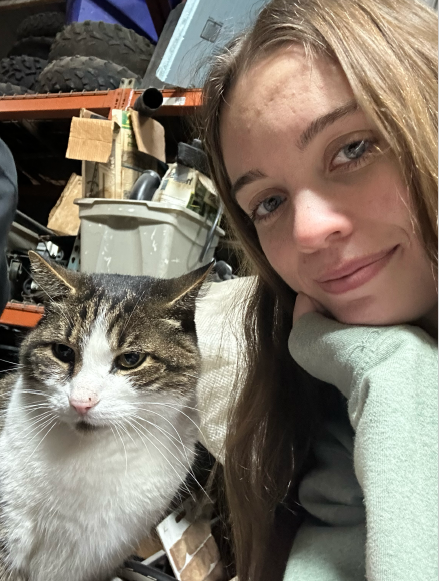
The Hollings Scholarship is awarded to approximately 130 undergraduate students for two years of full-time study and a 10-week summer internship at a NOAA facility. The Hollings Scholarship program was established in 2005 in honor of Senator Ernest F. Hollings - a champion for ocean policy and conservation - of South Carolina. Intended to bolster undergraduate training in NOAA mission sciences, as well as increase environmental literacy, the award provides recipients with hands-on, practical experience in NOAA-related research, technology, policy, management, and education. Read more about the Hollings Scholarship Program >>
NWS Deputy director gives keynote address at annual russell l. desouza banquet
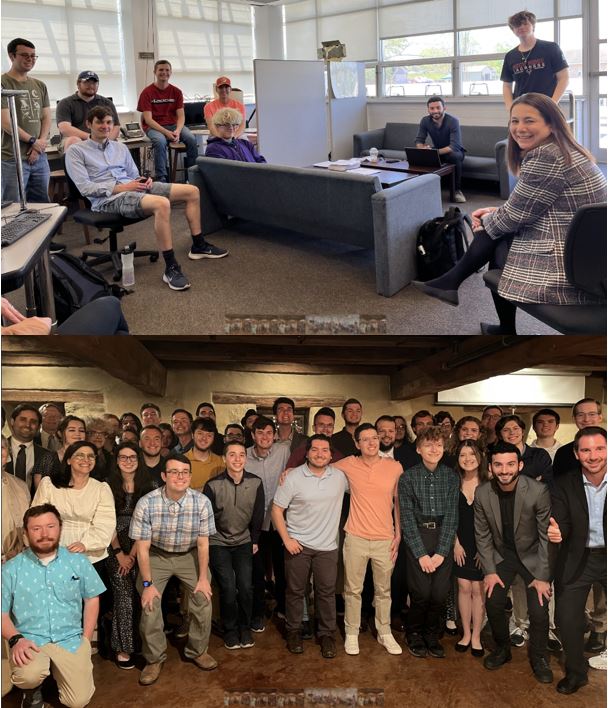
The Millersville University Student Chapter of the American Meteorological Society (MU-AMS) hosts the annual Russell L. DeSouza Banquet to celebrate the academic year and graduating seniors. In 2024, the banquet was held on Friday, April 26th, at the Country Barn Market in Lancaster County. Michelle Mainelli, the Deputy Director of the National Weather Service (NWS), gave the keynote address at the banquet. She also met with students during an informal session prior to the banquet in the University's Weather Information Center to discuss career opportunities in the NWS. Millersville Meteorology Alumnus Mary Fairbanks ('94), now the supervisory meteorologist at NOAA managing NWS verification metrics and service assessments, also spoke with students about her career and ways to prepare for the professional workforce.
Millersville meteorology celebrates 50th anniversary of first graduate
John Jensenius, the first Millersville Meteorology graduate from the Class of 1974, wrote a personal reflection on his time at the university to commemorate the 50th anniversary of his graduation.
"Scroll down Millersville's long list of meteorology graduates and there, way down at the very bottom, you'll find my name, the class of 1974. That was 50 years ago and, needless to say, a lot has changed since then. Let's see… at that time, the name was Millersville State College, there was no internet, no computers, and not even electronic calculators. We had a NAFAX facsimile machine, paper, colored pencils, and slide rules. In fact, the slide rule was one of the most important tools a meteorology student could have, as it was used to do all the calculations needed for meteorology, physics, and chemistry.
In the early 70s, meteorology classes were very small. While memories of dynamics, thermodynamics, physical, and synoptics classes have faded, I think most of my meteorology classes had three students or less. Needless to say, you didn't dare fall asleep! Synoptics classes were held around a large light table in the first floor of Lancaster House (now Nichol’s House). We spent one entire semester hand-plotting and hand-analyzing a variety of maps. In particular, I remember using our 500 mb analyses to generate maps of vorticity, vorticity advection, thermal advection, etc., by using GRAPHICAL finite difference methods. By the end of the semester, you had a full array of maps from which you could finally make a forecast.
As is typical of most meteorology students both then and now, the most exciting place was the map room. At the time, the map room was a corner closet on the first floor of Roddy Science Center. As storms approached, the NAFAX facsimile machine (our one source of real data) couldn't churn out those fuzzy charts fast enough. First came a hand-plotted surface analysis; then, the upper air charts; and finally, what we were waiting for – the progs. The first prog to come out of the fax was the "Barotropic" model – a four panel chart with heights and vorticity; then came the Primitive Equation ("PE") model with even more information; and finally, the latest and greatest forecasting tool – the Limited-area Fine Mesh ("LFM") Model. All of these computer models were run on a large mainframe computer in Suitland, Maryland. Now, of course, they could all be run on a personal computer.
At Millersville in 1974, we tracked storms solely based on surface observations. There was no radar data available. In fact, the WSR-74 was just being developed to replace the WSR-57 at National Weather Service offices. And, the WSR-74 was replaced 30 years ago by the WSR-88Ds. Now students are treated to instantaneous data from the X-band RADAR that sits atop the water tower. As for the view from space, there were no geosynchronous satellites (GOES 1 was launched in 1975). The only satellite information we received was from a polar orbiter. Twice a day (once during the day, once at night), the NAFAX machine would spit out a very fuzzy infrared image of our slice of the earth taken as the satellite passed overhead.
Like today though, we used all of the available information to create a local forecast. Our forecast 50 years ago was handwritten on a piece of paper and then posted on the bulletin board outside the map room. In addition, twice a day, I would walk my forecast up to the Millersville State Radio station (then WMSR) where I recorded the latest forecast.
So, what hasn't changed? --The excitement surrounding a good winter storm or severe weather outbreak; the valuable information provided by meteorology faculty; and the enthusiasm of meteorology students to apply recently-acquired knowledge to real-time events. Throughout my career, I've been told how lucky we are to do something we love. It's absolutely true!"
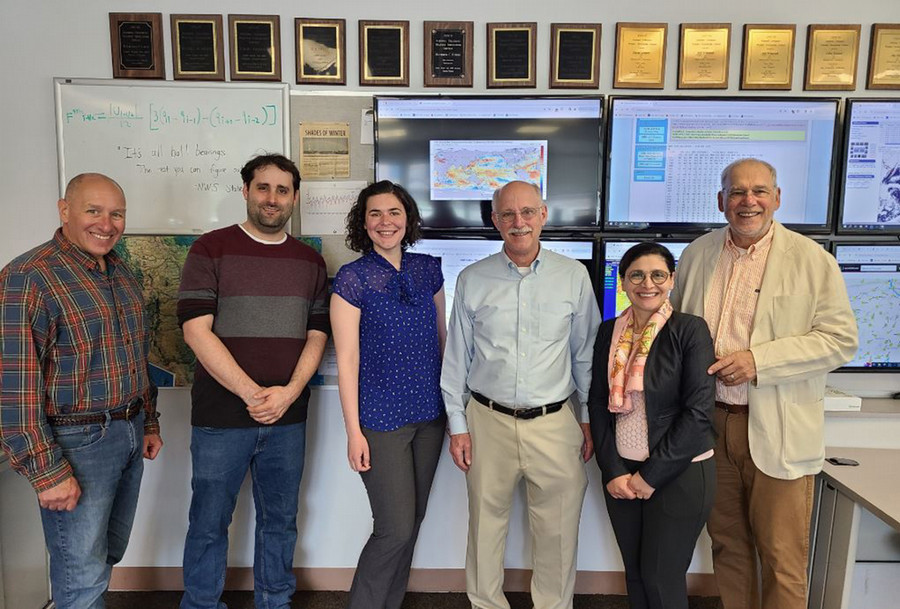
Pictured from left to right are: Drs. Todd Sikora, Greg Blumberg, Ellie Casas, Mr. John Jensenius, and Drs. Sepi Yalda and Richard Clark.
Below are comments from Dr. Richard Clark, Professor of Meteorology Emeritus, on John's storied career.
"John Jensenius was Millersville's first Meteorology graduate in 1974, receiving a BA degree in Earth Science/Meteorology. After Millersville, John earned an MS degree in Meteorology from the Pennsylvania State University in 1976. John began his professional career teaching meteorology and climatology at the State University of New York at Oneonta. From 1977 through 1994, John worked for the National Weather Service's (NWS) Techniques Development Laboratory (TDL) (now Meteorological Development Laboratory) where he developed statistical forecast products used by meteorologists nationwide. In addition to his normal job responsibilities at TDL, John initiated efforts that eventually led to the development of the BUFKIT program. From 1995 until his retirement in 2019, John served as the Warning Coordination Meteorologist at the NWS office in Gray, Maine. While there, John initiated a nationwide lightning safety campaign in 2001 and served as NOAA's media specialist on lightning safety. Since John's retirement, he has led the National Lightning Safety Council and continues to be a national leader on lightning safety. During his career, John received numerous awards including the National Weather Association's Public Education Award and Department of Commerce Bronze and Silver Medals."
Millersville alumni, faculty, and students attend 104th ams conference
This year marked the 38th straight year that students in the Millersville Meteorology program had an opportunity to attend the Annual Meeting of the American Meteorological Society (AMS). Thirty students attended the 104th Annual Meeting of AMS in Baltimore, MD, from January 27-Febaruary 1. In addition to attending all other conference sessions and special symposia during the week, students had the opportunity to take part in the AMS Student Conference. Keelie Steiner, Wes Taylor, Victoria McPeek, and Matthew Teare presented their research as part of the student research poster session. Three graduate students from the Master of Science in Emergency Management and the Master of Science in Integrated Scientific Applications attended the Annual Meeting.


Additionally, Millersville University meteorology and emergency management programs hosted the MU Alumni and Friends reception on January 30th where over 200 students, alumni, and friends of the programs attended the celebration. Dr. Daniel Wubah (MU President), Dr. Gail Gasparich (MU Provost), Dr. Victor Ramos (Vice President for Advancement), and Dr. Marc Harris (Dean of the College of Science and Technology) were present, along with a number of meteorology and emergency management faculty and staff and staff from the MU Advancement. Dr. Rich Clark (Professor of Meteorology, Emeritus and Past President of the AMS) and Dr. Sepi Yalda (Professor of Meteorology, CDRE Director) served as co-organizers for the event. The event was sponsored by generous donations from Climavision, WeatherTrends, AccuWeather, and Millersville University’s Alumni Association.

Faculty & students assist achd in validation of wind/temperature measurements
On October 4-5, three meteorology students from Millersville University assisted the Allegheny County Health Department (ACHD) with a research initiative involving Sound Detection and Ranging (SODAR) observations and Radio Acoustic Sounding System (RASS) retrievals with rawinsonde measurements in Clairton, Pennsylvania. Under the direction of faculty members Dr. Greg Blumberg and Dr. Richard Clark, as well as Weather Center Director Kyle Elliott, the students launched weather balloons to validate the on-site SODAR measurement, a requirement of the EPA. A radiosonde, or instrument used to transmit pressure, temperature, and relative humidity measurements at various levels of the atmosphere, was attached to each balloon. When a radiosonde is tracked so that wind speed and direction measurements are also provided, it is called a rawinsonde observation. The data collected was used to better understand the changes in the diurnal transition of the planetary boundary layer in the Monongahela Valley and its impact on the transport of pollutants.

Each year since 2018, Millersville faculty and students have conducted a series of rawinsonde launches over the course of 2-3 days for the purpose of validating the wind and virtual temperatures measurements obtained by the ACHD using a Scintec Acoustic SODAR system with a RASS extension.
commemorating joe calhoun's legendary career
On January 18, 2024, Millersville Meteorology faculty, students, and alumni gathered in the Weather Information Center to celebrate Joe Calhoun's retirement and commemorate his 36-year tenure as Chief Meteorologist of the WGAL News 8 Storm Team. Calhoun ended his memorable and successful career at WGAL News 8 on January 19, 2024, and thus did some of his final broadcasts the prior evening at Millersville. Calhoun's track record in accurate and reliable forecasting has been unmatched, and south-central Pennsylvania residents got to hear him "tell a story" about the weather for over three decades.

Calhoun graduated from Penn State University in 1981 with his bachelor's degree in meteorology. His career began at Freese-Notis Weather in Des Moines, Iowa. Thereafter, he joined Hearst Television's KETV in Omaha, Nebraska, as the morning meteorologist. In 1987, Calhoun returned to his home state of Pennsylvania and joined WGAL News 8 in 1987.
In addition to his on-air career, Calhoun taught a course in broadcast meteorology at Millersville University for more than two decades. His mentorship kick-started the careers of many then-student meteorologists, including a few members of the WGAL News 8 Storm Team. Christine Ferreira, a 2004 graduate of Millersville's Meteorology program, has been promoted to Chief Meteorologist at WGAL News 8 in Calhoun's stead.
"When I look back on my career, I'm most proud of the team I've built here at WGAL 8 and the students and young broadcasters whom I've impacted along the way. Seeing them blossom into stellar meteorologists has been a wonderful experience," Calhoun said.
Millersville Meteorology and the Earth Sciences Department would like to personally congratulate Calhoun on his retirement, thank him for his years of service to the University, and wish him all the best!
Millersville Meteorology students deploy aerokats for pbl research
Millersville Meteorology students in Dr. Greg Blumberg's Boundary Layers & Turbulence class (ESCI 448) deployed the first small-scale, multi-kite network to characterize the low-level Planetary Boundary Layer (PBL) weather conditions. The AEROKATS systems used is National Aeronautics and Space Administration (NASA) technology provided by the AEROKATS and ROVER Education Network (AREN) Science Activation Team.
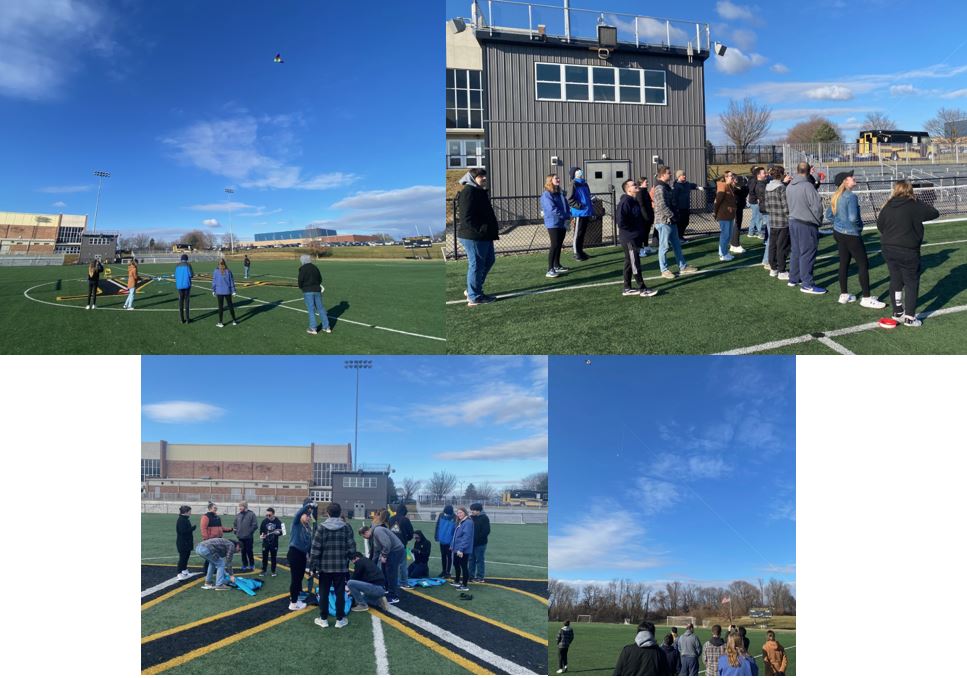
Millersville METEORology students Excel in wxchallenge
WxChallenge is a collegiate-focused meteorological forecasting competition. It is a non-profit entity, whose income is used to maintain necessary infrastructure, promote the competition to students and faculty, and provide non-cash awards (trophies) for excellence in forecasting. Forecasters predict the daily high and low temperatures (in degrees Fahrenheit), maximum sustained wind speed (in knots), and cumulative liquid precipitation amount (in inches) for select locations across the United States. To allow for fair competition, forecasters are separated into categories. Category 3 forecasters include junior- and senior-level students, and Category 4 forecasters include freshman- and sophomore-level students. The competition runs for 10 weeks in the Fall semester and 10 weeks in the Spring semester. During this time, there are a total of 10 locations in which forecasts are made. In each location, forecasts are produced for a two-week period. At the end of that period, the top two students in each category receive trophies for their outstanding performance. There is an additional three-week tournament following the end of the Spring semester for the top 64 overall best forecasters.
Millersville Meteorology students have a long track record of success in WxChallenge. The 2022-2023 academic year has been no exception, with multiple students across all class levels winning awards. Below is a list of the top finishers from Millersville in select cities:
- Peter Corman: Runner-up finish (Category 4) in Knoxville, Tennessee (Oct. 10 - Oct. 24).
- Mark Battle: 1st-place finish (Category 4) in Milwaukee, Wisconsin (Oct. 24 - Nov. 7).
- Alex Massa: Runner-up finish (Category 3) in Olympia, Washington (Nov. 7 - Nov. 21).
- Peter Corman: Runner-up finish (Category 4) in Denver, Colorado (Jan. 23 - Feb. 6)
- Alex Sullivan: 1st-place finish (Category 4) in Atlanta, Georgia (Feb. 6 - Feb. 20).
- Gavin Morgan: Runner-up finish (Category 4) in Atlanta, Georgia (Feb. 6 - Feb. 20).
- Matthew Teare: 1st-place finish (Category 3) in Augusta, Maine (Feb. 20 - Mar. 6).
- Peter Corman: 1st-place finish (Category 4) in San Angelo, Texas (Mar. 6 - Mar. 20).
- Ethan Kerr: Runner-up finish (Category 4) in San Angelo, Texas (Mar. 6 - Mar. 20).

Congratulations on demonstrating true forecasting acumen in these difficult cities!
Millersville students, alumni, and faculty attend space weather workshop

The 2023 Space Weather Workshop was held from April 17-21 in Boulder, CO, and brought together instructors, graduates, and students of the space weather programs at Millersville University. Pictured in the front row are, from left-to-right: instructors Drs. Tamitha Skov, Jennifer Meehan, and Sepi Yalda, who is also the program coordinator, and program graduates Sara Housseal and Samantha Carlson. Pictured in the back row are, from left-to-right: instructors Michael Cook and Dr. Richard Clark, program founder and emeritus faculty, Tim Keebler, Ph.D. student at the University of Michigan, Athony Williams, graduate student in the Integrated Scientific Applications program, and Wes Taylor, undergraduate meteorology major with a minor in Heliophysics and Space Weather. The group presented three posters and participated in the week-long workshop, whose banquet keynote speaker, Erin Wolf of Ball Aerospace, amazed the audience with a presentation and stunning images from the James Webb Space Telescope.
Millersville alumni, faculty, and students attend 103rd ams conference
Millersville Meteorology students, alumni, and faculty attended the 103rd Annual Meeting of the American Meteorological Society (AMS) Conference in Denver, Colorado, from January 7-13, 2023. For the first time since 2020, the conference was held both virtually and in-person. Students were able to network with students from other universities and the professionals in attendance. On January 10, students, alumni, and faculty attended the Millersville University Alumni and Friends Reception. Pictured below are a group of 4 alumni at the reception: Jason Taylor, Amber Liggett, Melissa Burt, and McArthur Jones (from left-to-right).

Several students had abstracts accepted for poster presentations at the student conference. Pictured below (left) is senior Alexander Massa discussing his summer research experience with a colleague. Alex participated in Penn State University's Climate Science Research Experiences for Undergraduates program and worked with Dr. Gregory Jenkins researching the variability of pollution across western and southern Africa on diurnal and seasonal timescales. He used data collected from low-cost air monitoring sensors located in countries such as Cabo Verde, Nigeria, and Angola to produce plots showing how particulate matter concentrations vary over time and impact air quality. Also pictured below (right) is Millersville's own Dr. Richard Clark, the 2022 president of the AMS, kicking off the Presidential Forum. As president, Dr. Clark spearheaded efforts to foster outreach and cross-sector collaboration across the enterprise, promote scientific breadth and diversity, stimulate opportunities for members, and use data to propel new science, create new knowledge and insights, guide policies and decisions, and advance the scientific, environmental, and societal dimensions of the weather, water, and climate enterprise.

Four members of Millersville Meteorology's Project TILTTING, or the Thermodynamic Investigation of LCL Thresholds at Tornadogenesis and its Influence in the Northeast and Great Plains, also designed posters for the student conference. Pictured are Ryan Argenti (top left), Rhiannon Cahoe (top right), Shane Martrich (bottom left), and Sam Leppo (bottom right). They discussed unique means of fundraising for the project, specifications of their prototype tornado probe, a mathematical proof of concept for deploying the probe into a tornado by drone, and a rear-inflow jet's influence on a Quasi-Linear Convective System (QLCS) in southeastern PA on August 30, 2022. Ryan and Shane also spoke at the 23rd Symposium on Meteorological Observation and Instrumentation: Innovative Technological Advances for Mesoscale Observing Systems on the final day of the conference.

OUTREACH AT Burrowes Elementary SCHOOL

On November 9, 2023, seven Millersville Meteorology students gave an interactive presentation on weather and climate at Burrowes Elementary School in Lancaster, PA. They educated the 3rd-grade class on topics such as the water cycle, El Niño-Southern Oscillation (ENSO), winter weather patterns, balloon launches, thunderstorms, and storm chasing protocols. Following the presentation, the students fielded questions from the 3rd-graders and their teachers. Millersville Meteorology is grateful to have participated in this incredible outreach opportunity!
Weather Balloon Launch 10-03-2023
Millersville meteorology faculty and students conduct a weather balloon launch for the UNIV 103 classes.
Millersville meteorology faculty and students conducted a pair of weather balloon launches for the UNIV 103 classes on October 3, 2023, for demonstration purposes and in preparation for the Clairton project near Pittsburgh, Pennsylvania. A radiosonde, or instrument used to transmit pressure, temperature, relative humidity, and wind measurements at various levels of the atmosphere, was attached to each balloon.
MILLERSVILLE METEOROLOGY
It’s more than a degree. It’s an experience! Join us!
Research, Activities and News
project tiltting created by Millersville METEORology students
Remember the group of Millersville meteorology students who chased the EF-3 tornado in Mullica Hill, NJ, during Hurricane Ida? Under the leadership of Weather Information Center Director Kyle Elliott, they created the Thermodynamic Investigation of LCL Thresholds at Tornadogenesis and its Influence in the Northeast and Great Plains (TILTTING) project. For details on the project and how to support the students, visit TILTTING (millersville.edu/tiltting). Nearly 20 students are involved in the project, and 7 of them deployed to the Great Plains for a two-week period during May 2024 to conduct tornado research. Under the guidance of Dr. Greg Blumberg, this "chase team" released balloons to obtain atmospheric profiles of temperature, pressure, humidity, and wind velocity near supercells to assess the storm environment. While in the Plains, the students visited the Storm Prediction Center (SPC) in Norman, OK, and talked with forecasters on the operations floor. They met with two of the senior leads at the SPC - John Hart and Rich Thompson - and toured the vehicle bays at the National Weather Center to see the mobile radars and mesonets. On chase days, the team shared the data collected with SPC and local National Weather Service (NWS) offices. Overall, four Intensive Observation Periods (IOPs) were conducted during the two-week period, and the team is aiming to present their findings at upcoming conferences.
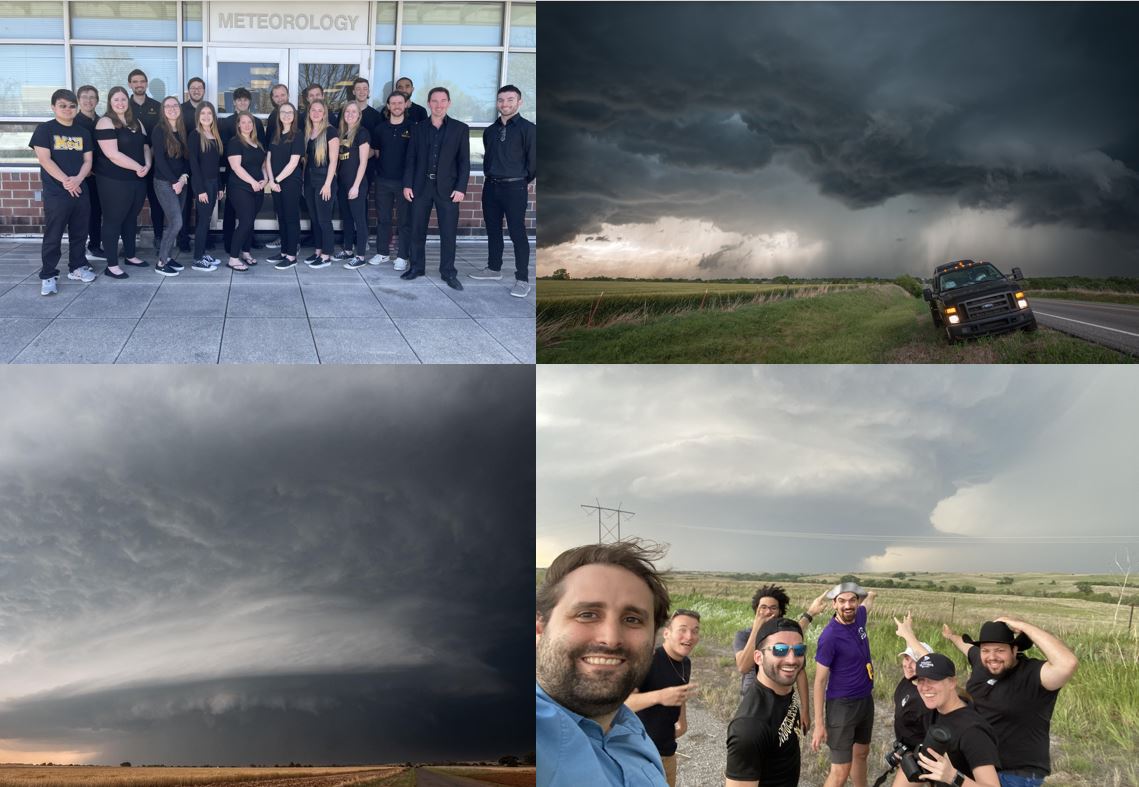
The students have also designed their own probes that will eventually be used to penetrate and measure wind velocity and pressure perturbations within the condensation funnel of a tornado. IOPs have and will continue to be conducted in the Northeast, with teams of 6-10 students deploying on a rotating basis. Three IOPs took place in the Northeast during Summer 2022, with another three happening during Summer 2023. Incorporation of this data into numerical weather prediction models will increase accuracy of severe weather forecasts, improve tornado warning lead times and, most importantly, save lives.

Highlight Video of MU Meteorology Research Opportunities
Space Weather Group Conducts First High-Altitude Balloon Measurements
A small group of meteorology majors, known as the Space Weather Group, conducted a maiden launch of a balloon carrying a payload of instruments for measuring X-rays, Gamma rays, and UV rays, as well as a radiosonde for collecting weather data. The balloon carried its payload to an altitude of 103,000 feet... Read more >>
Weather Watch TV
The latest edition of MU's Weather Watch!
Program Information at a Glance
Download a printable Program Information at a Glance PDF file for more information.
